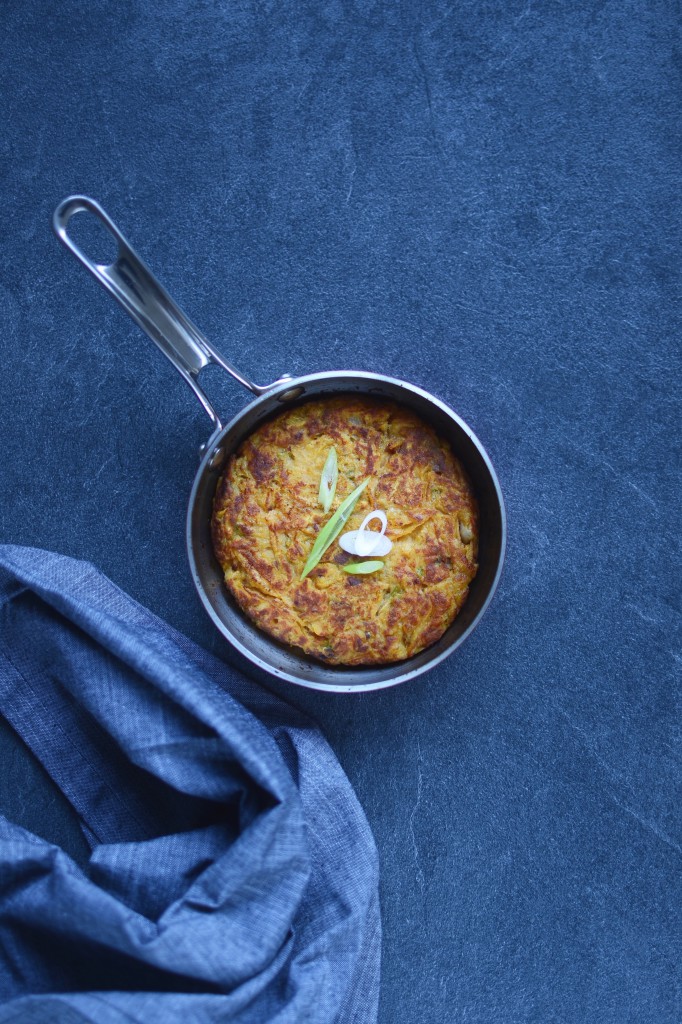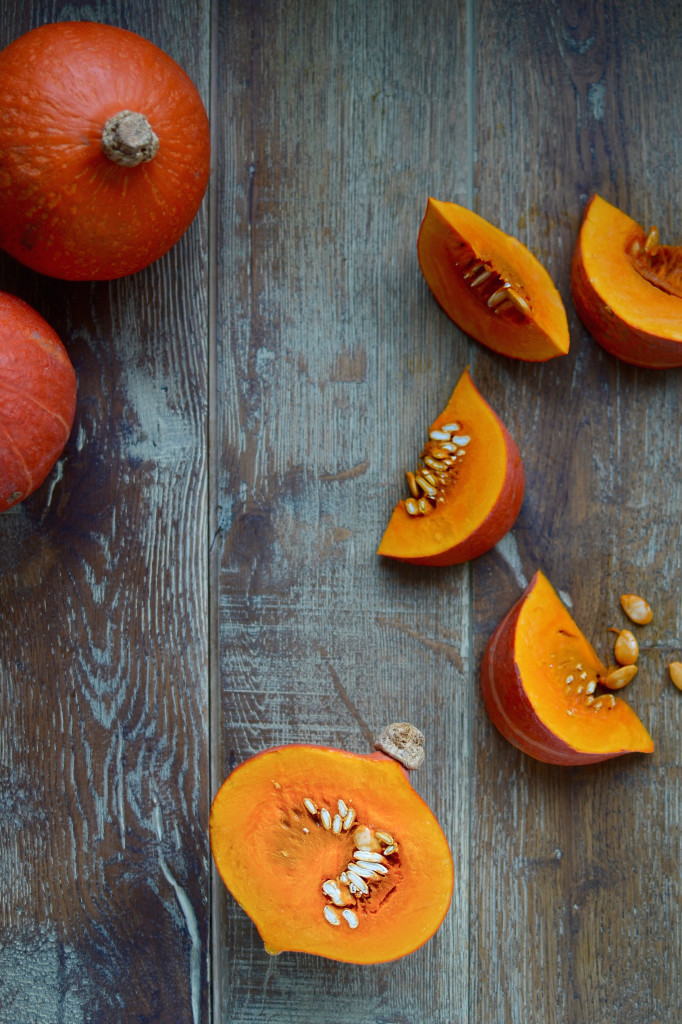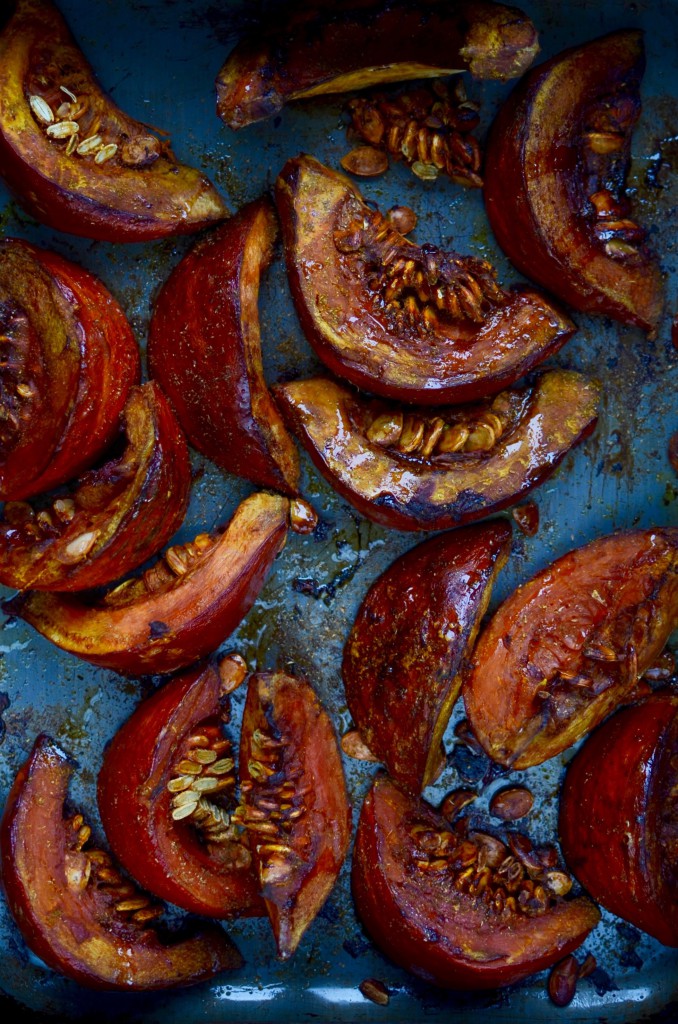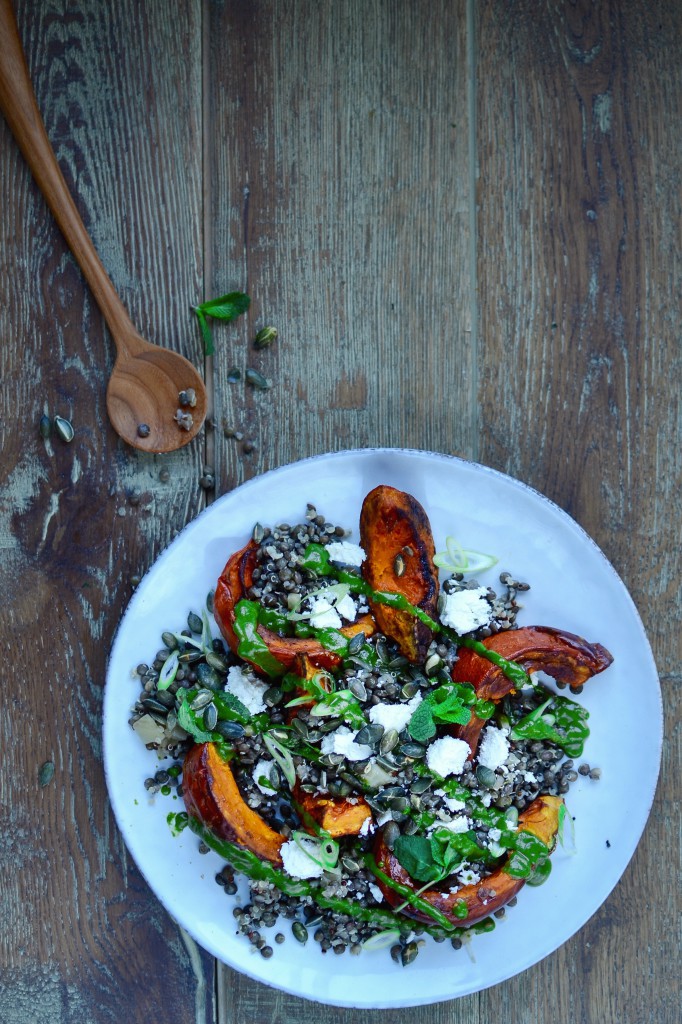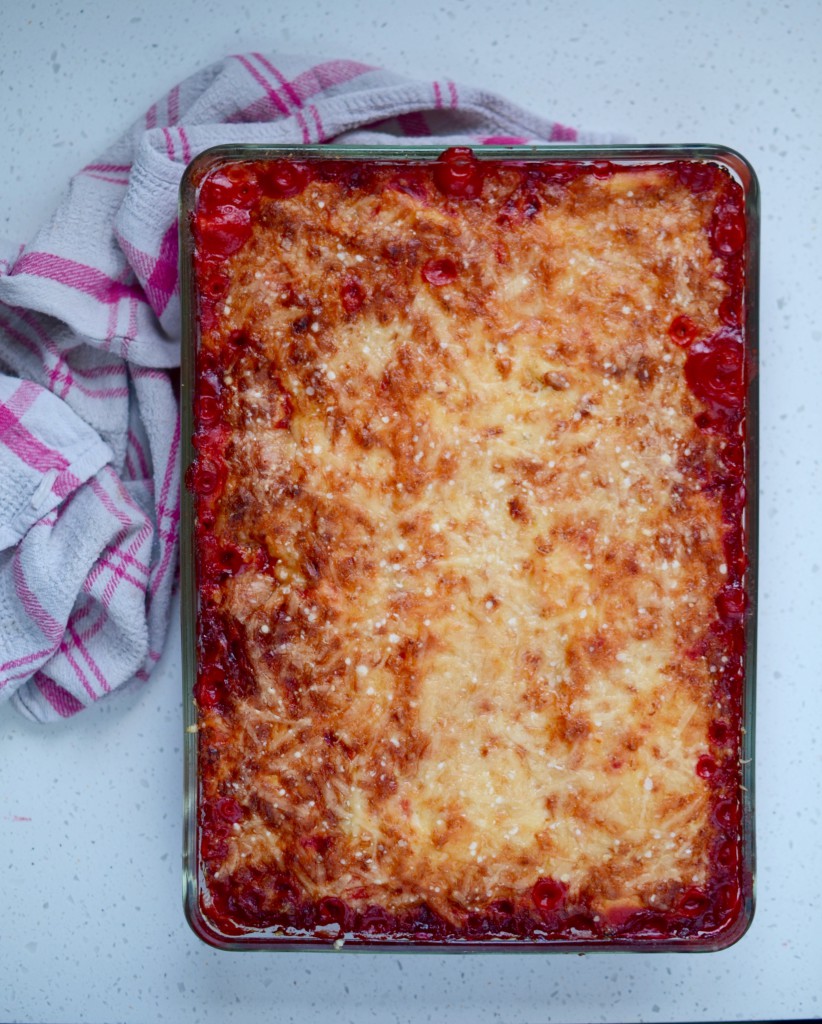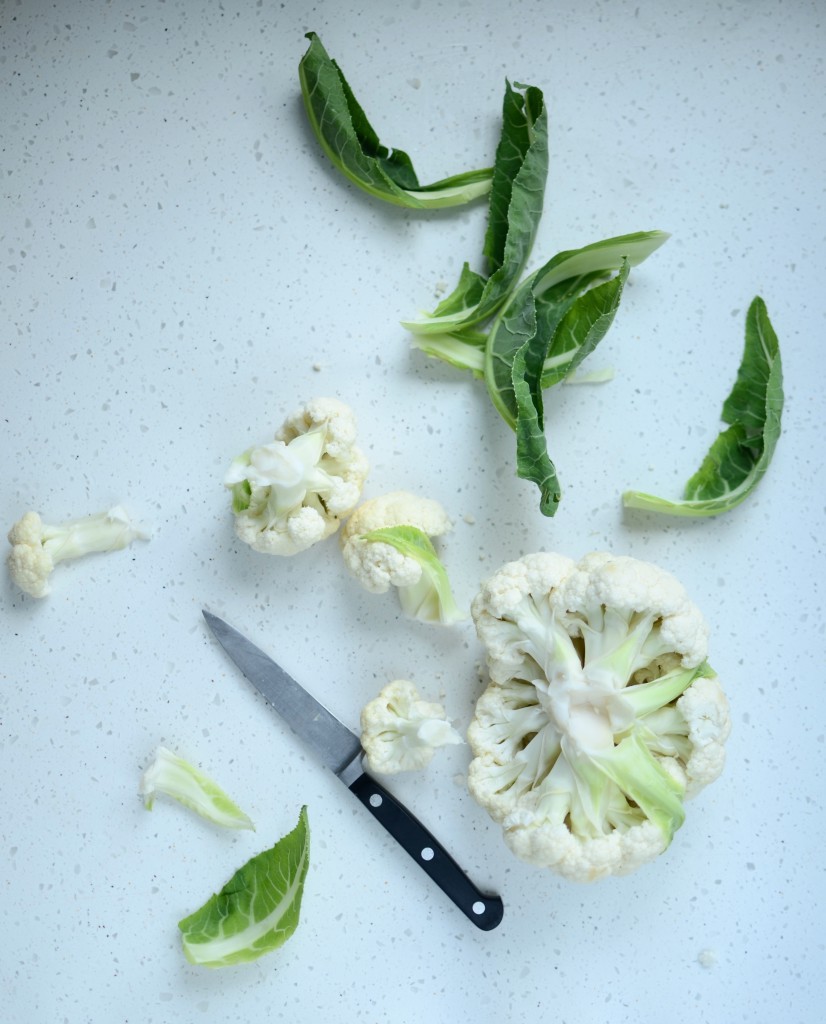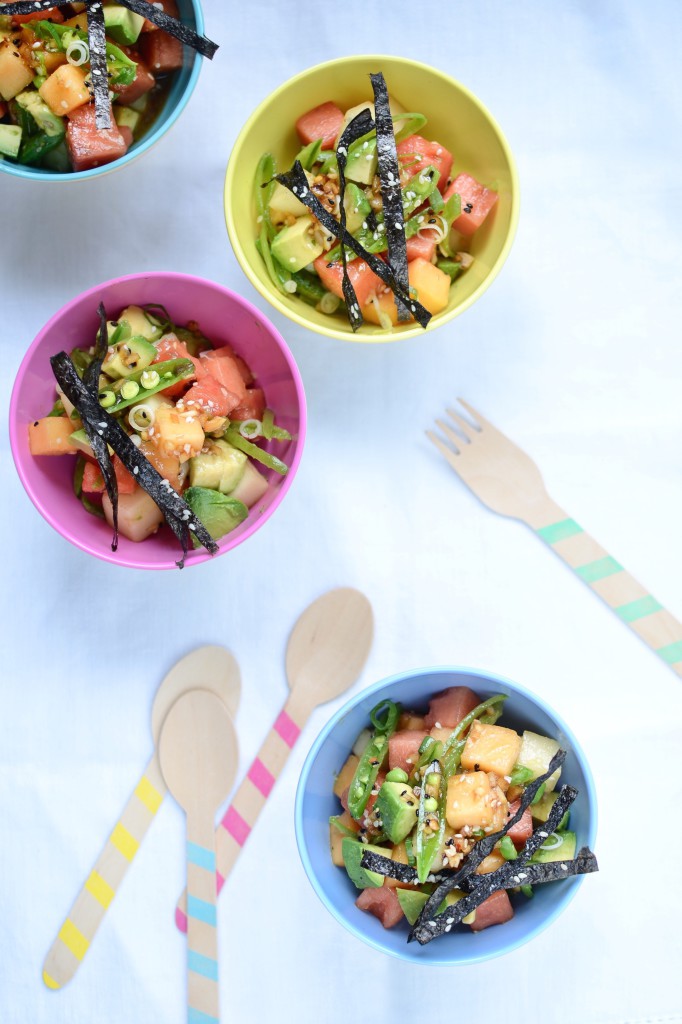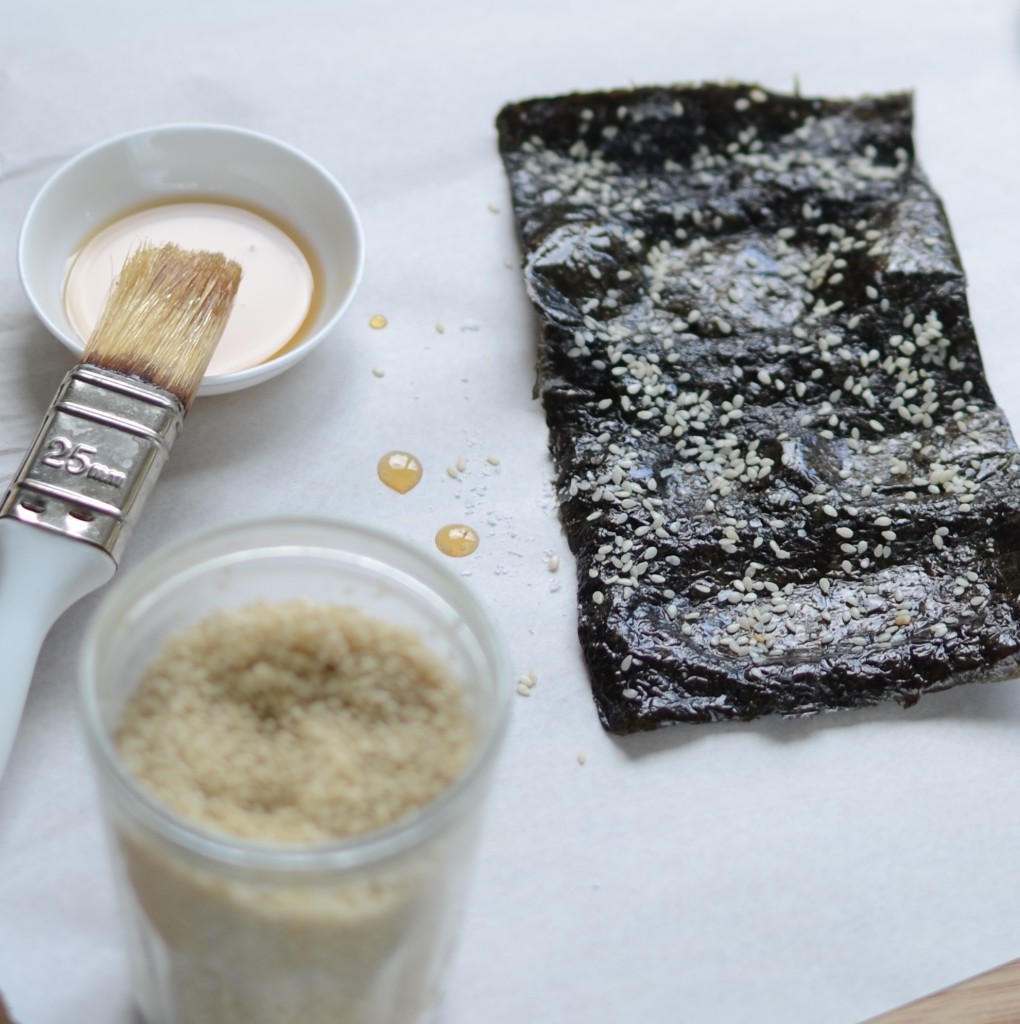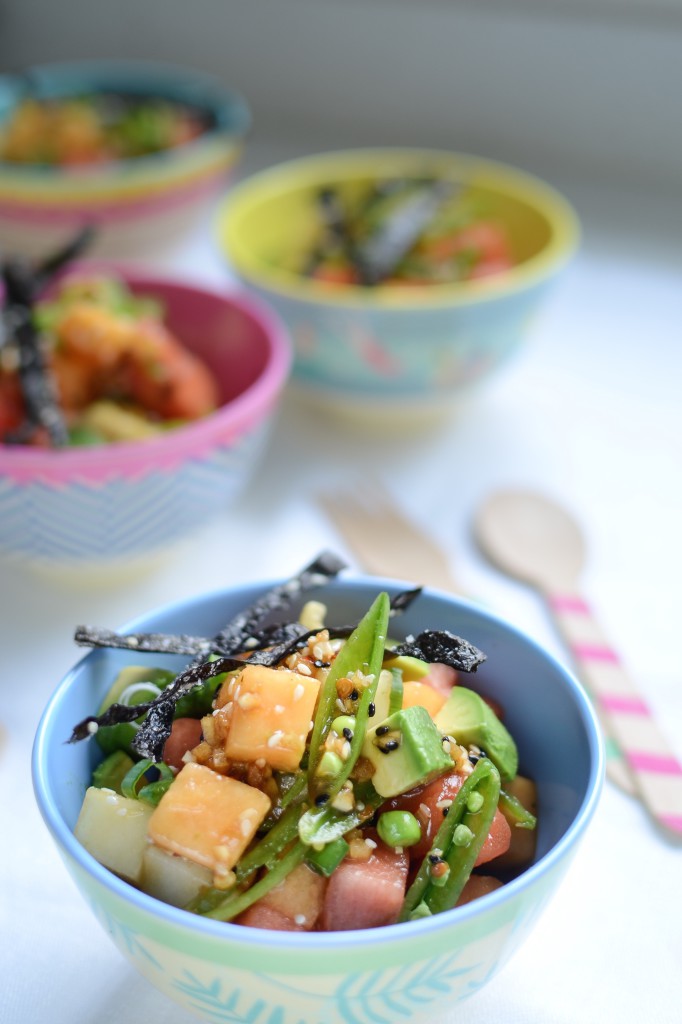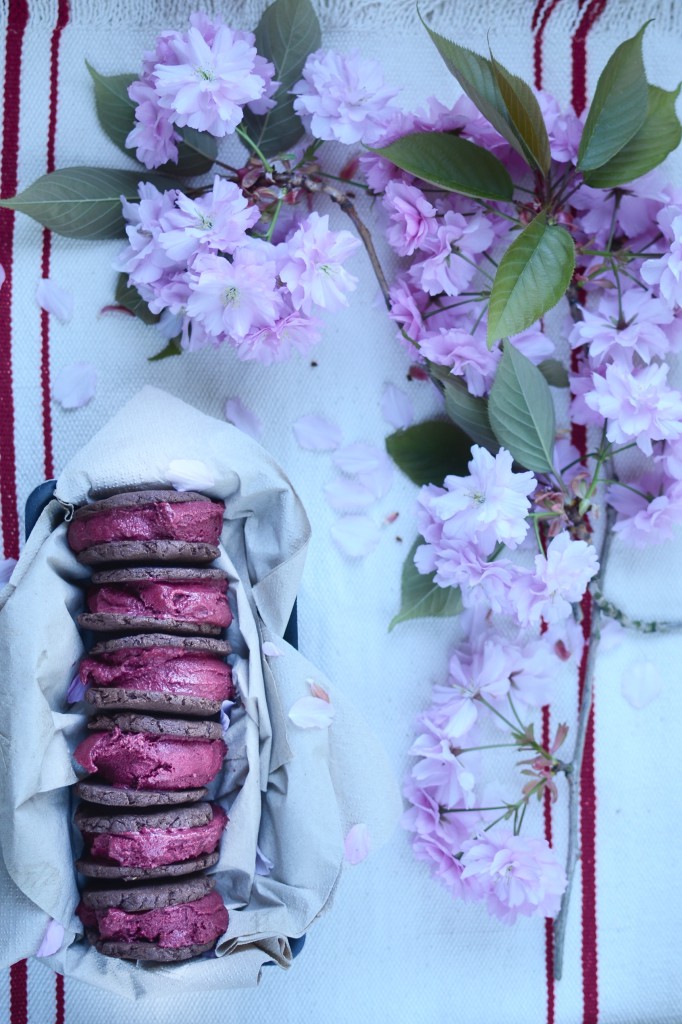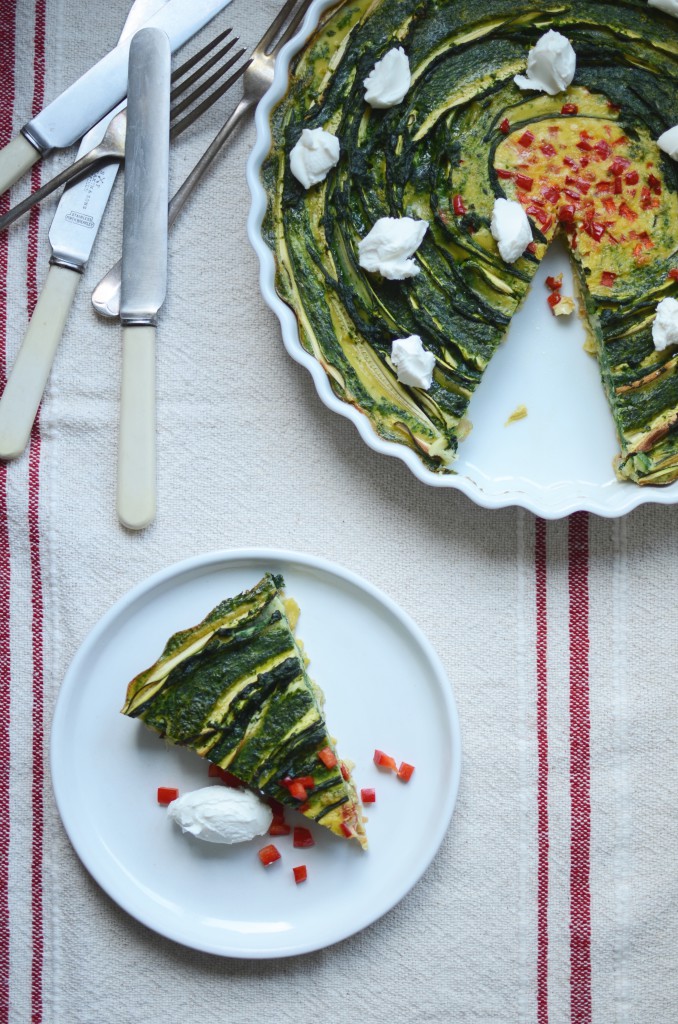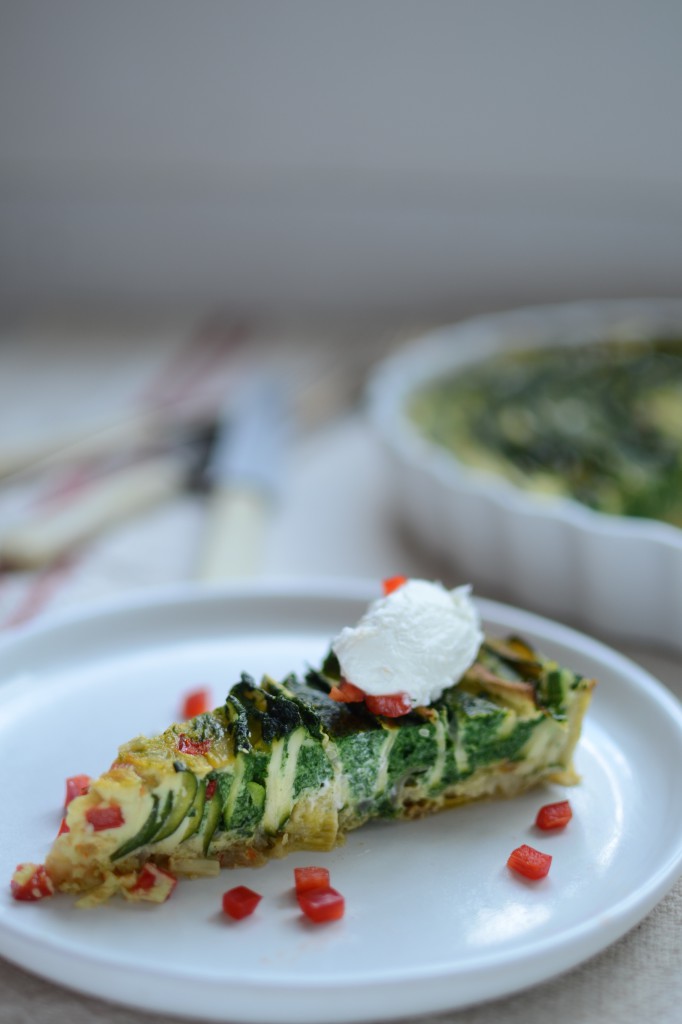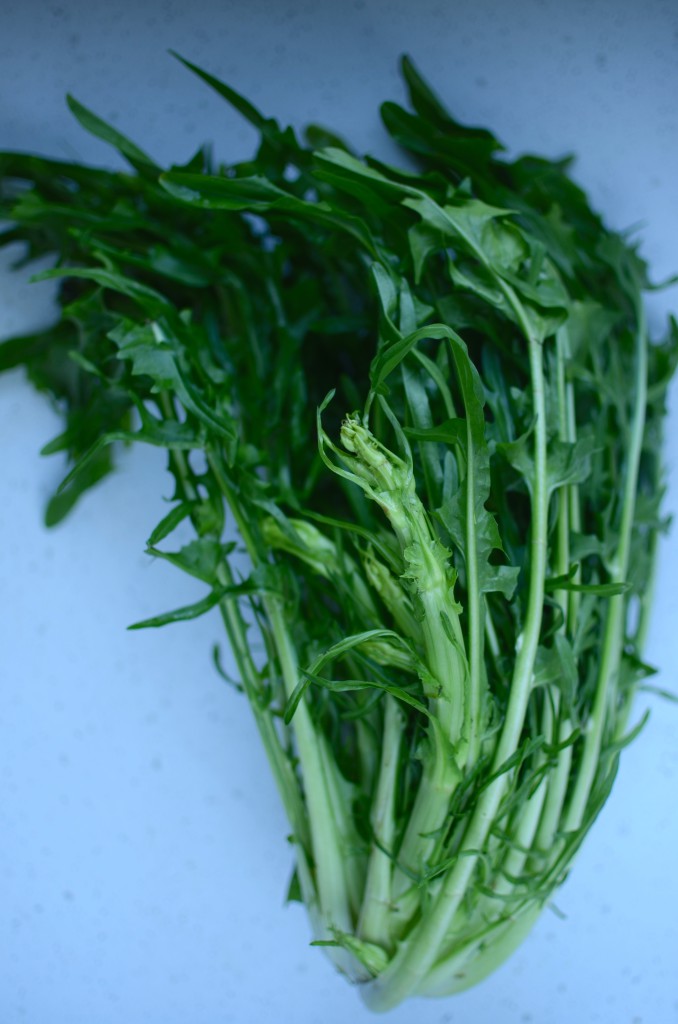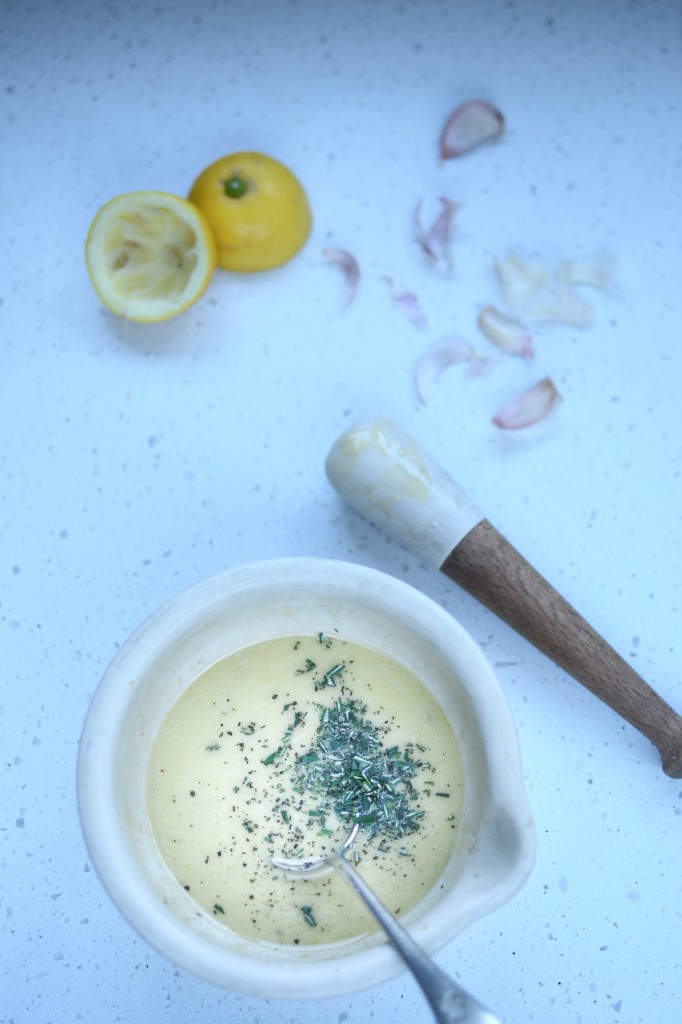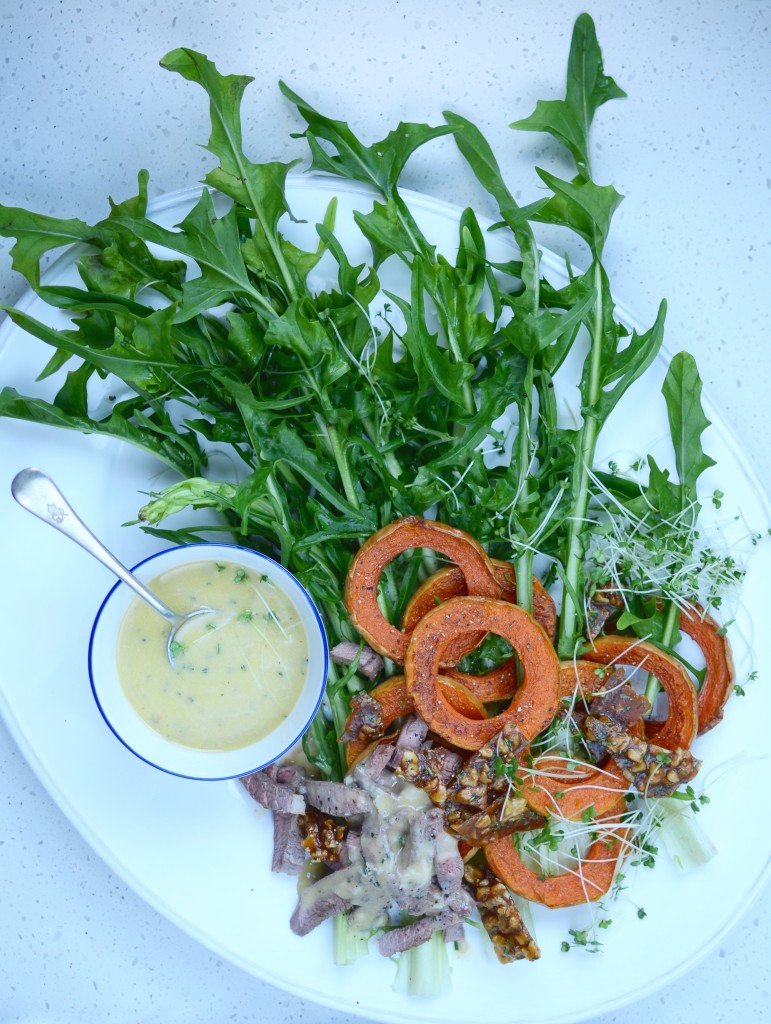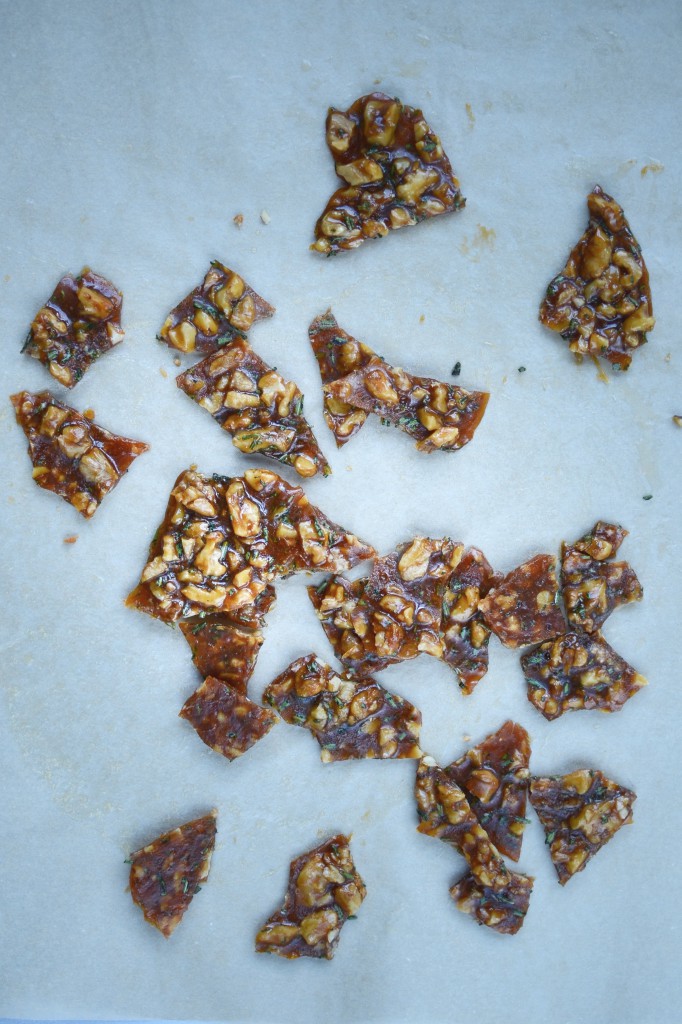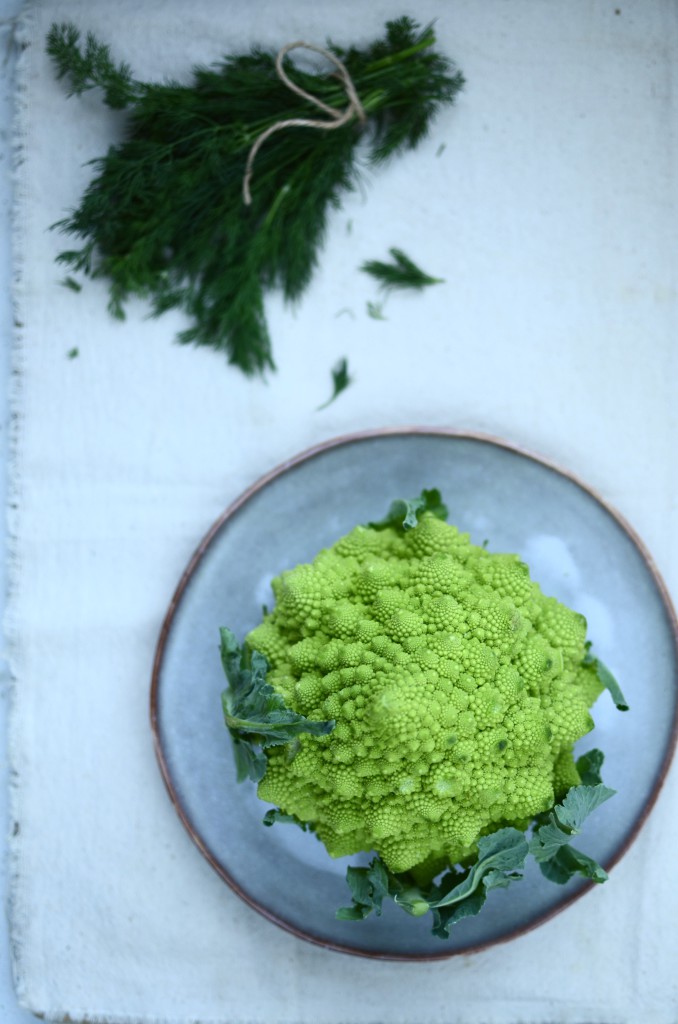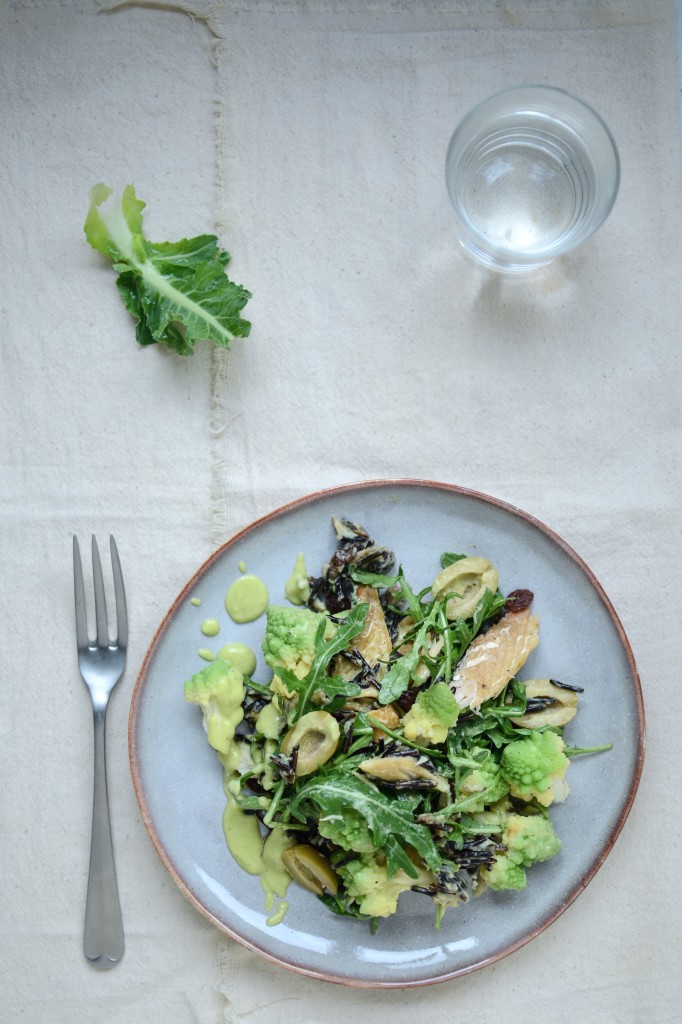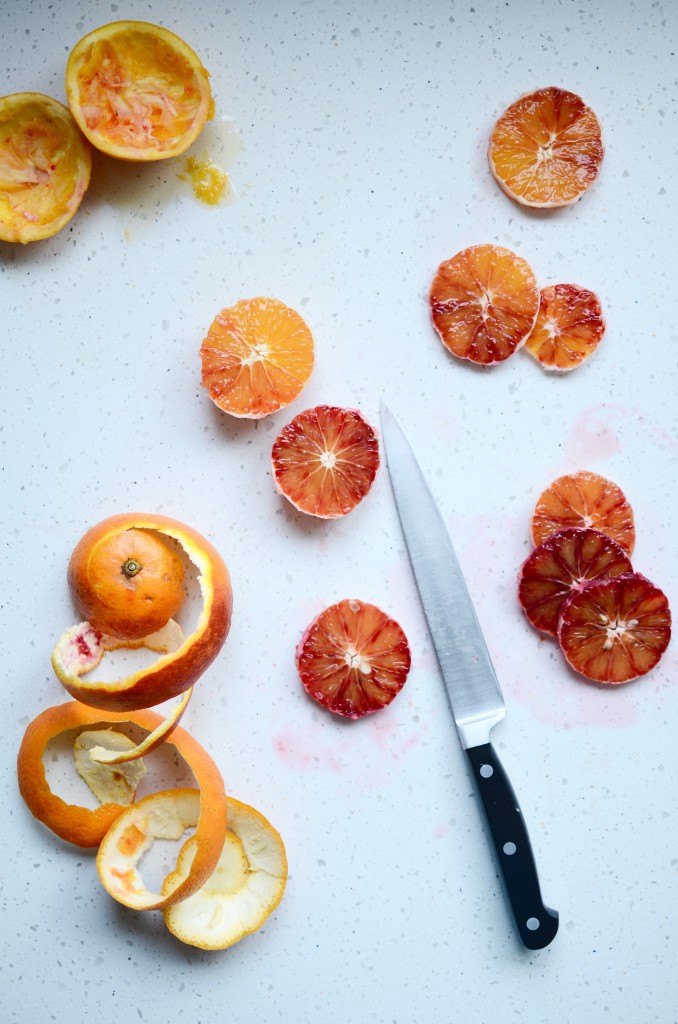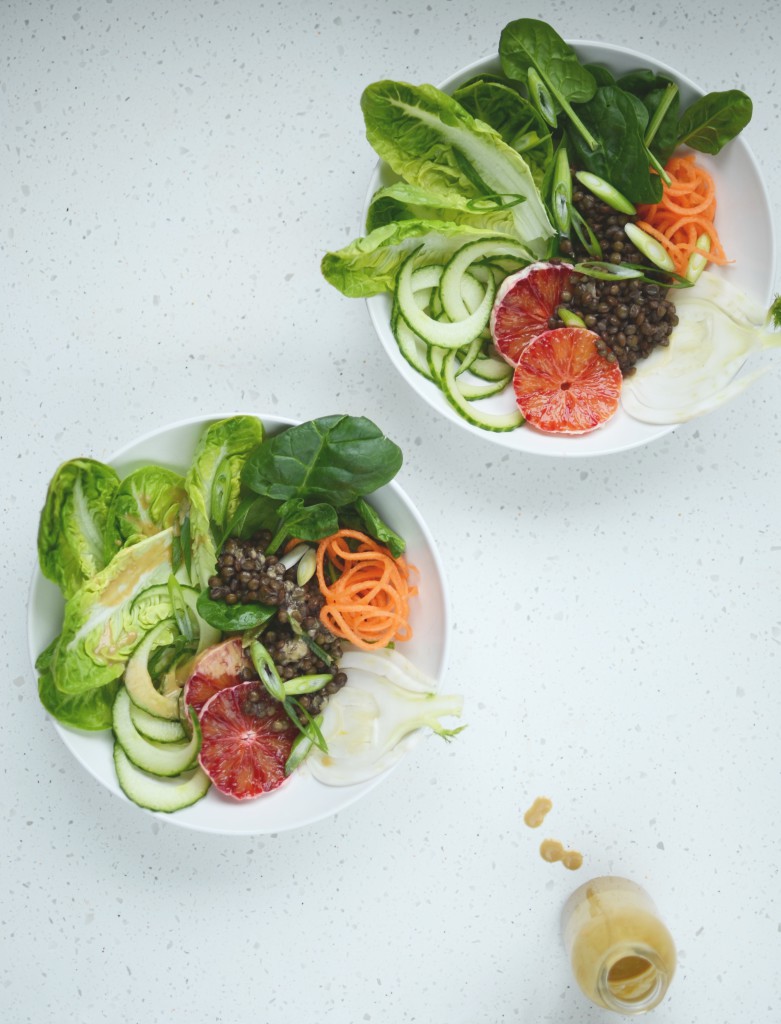Bergamot and cucumber salad
I only recently discovered my love for Earl Grey tea. Not the regular kind, mind you. It was the combination of Redbush tea from my homeland with the intoxicating aroma from the Bergamot oil that swayed me. The Bergamot orange (sometimes mistakenly referred to as a lemon) was created more than 300 years ago in Southern Italy when a sour orange was crossed with a citron/lemon/lime/Palestine sweet lime. No one is quite sure. The oil is extracted from the rind and used in Earl Grey teas, as well as fragrances, aromatherapy and to flavour dishes. Here I’ve put them to good use in a refreshing salad dressing with cucumber and blueberries. But the options really are endless…
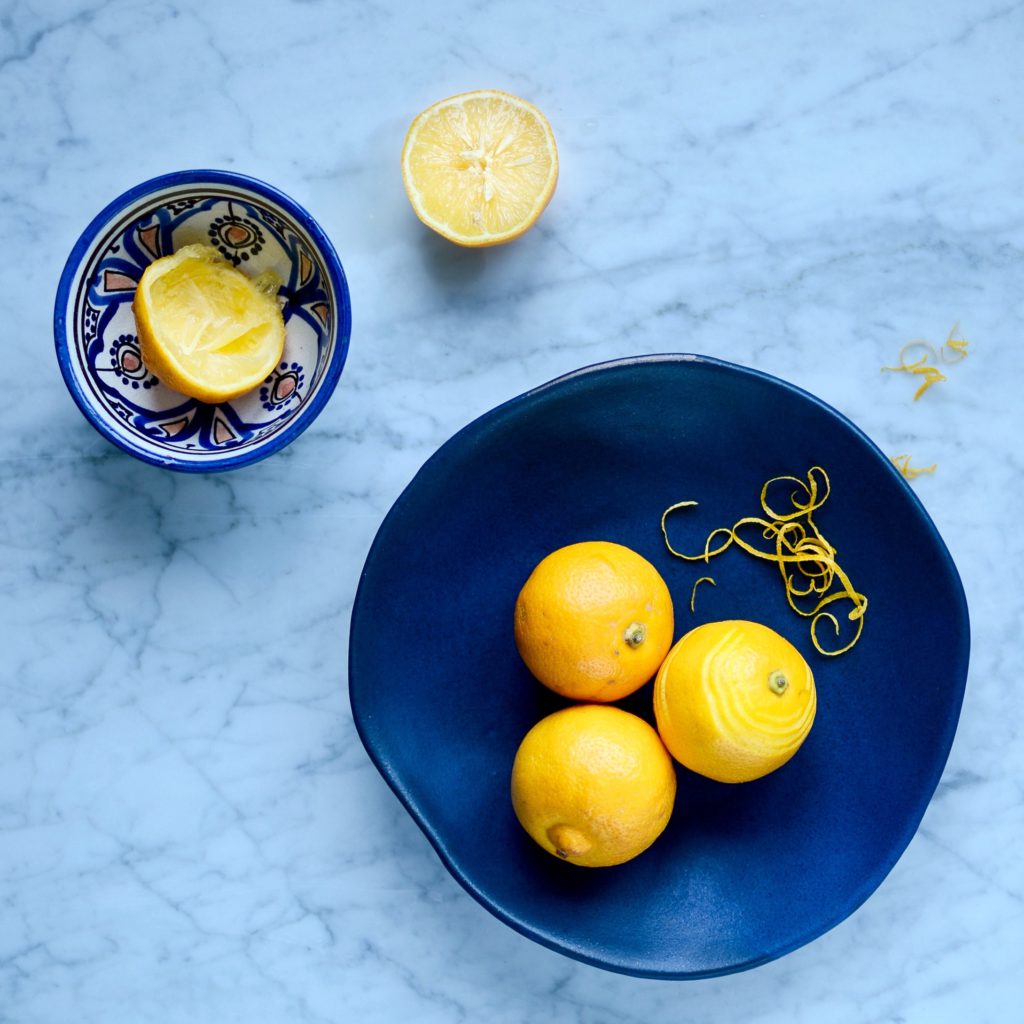
Bergamot lemon cucumber salad
If you cannot find Bergamot oranges (in season from December to February) try a combination of lemon, grapefruit and orange or tangerine, although the distinctive floral, slightly bitter flavour is difficult to replicate.
Serves 4 – 6
Ingredients for the salad
2 English cucumbers, peeled if not organic
1 punnet blueberries (about 125g), washed and halved if you prefer
a large handful of pistachio nuts, roughly chopped
Ingredients for the dressing
zest of 2 Bergamot oranges
juice of 1 Bergamot orange
80ml thick Greek yoghurt (or coconut yoghurt)
45ml (3 tablespoons) extra virgin olive oil
1 garlic clove, crushed
large pinch of unrefined rock or sea salt
1 – 2 teaspoons raw honey (or maple syrup), or to taste
small bunch of dill, leaves only, finely chopped
Method
- Thinly slice the cucumber on the diagonal and gently toss with a pinch of unrefined salt. Place the cucumber slices in a colander over a bowl or in the sink and allow to drain for at least half an hour.
- Put all the ingredients for the dressing in a jar, screw on the lid and give it a good shake until the honey is dissolved.
- Add the rest of the salad ingredients, toss with the dressing and serve immediately.
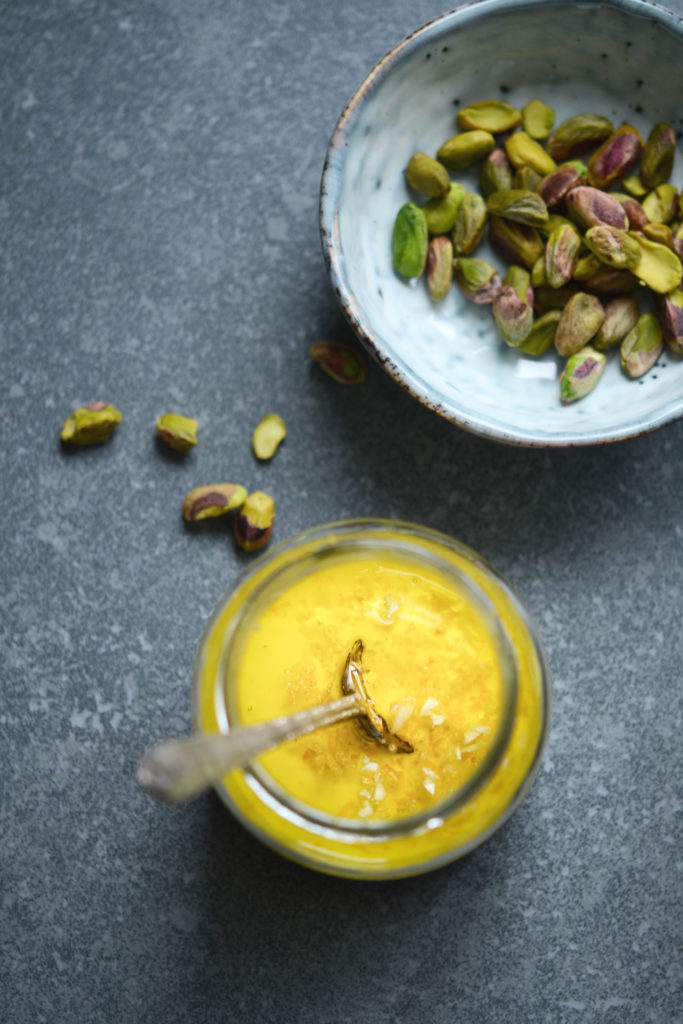
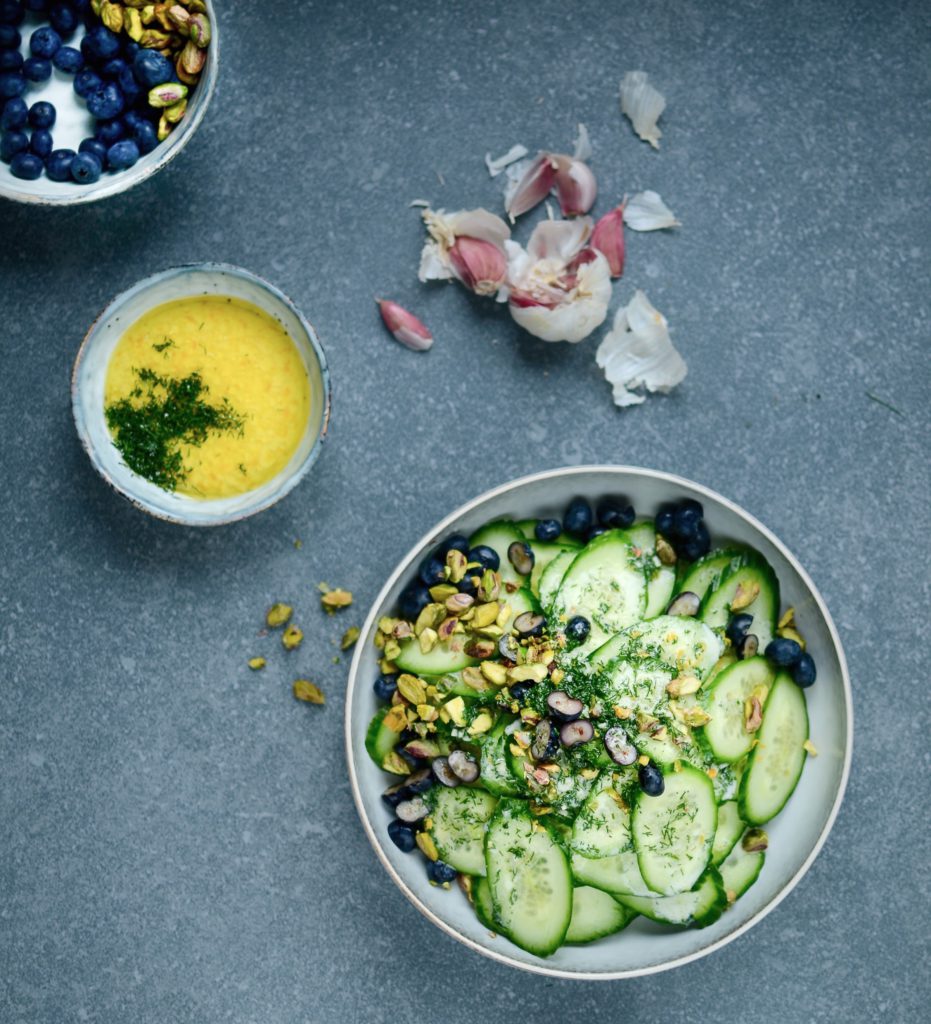
Sweet potato rösti with Caesar kale
My biggest gripe with classifying something as an of-the-moment superfood, is that it inevitably leads to that food going “out of fashion” at some stage. It is such a shame, as many so-called superfoods really are fantastic, nutrient-dense foods that have a lot to offer. It was kale this and kale that for quite some time, but this wonderful veg seems to have fallen out of favour. Don’t be a fashion victim! Add this brunch dish, that I developed for the M&S Super Brunch Campaign, to your Boxing Day brunch, and rediscover an old favourite.
The Caesar-style dressing is delicious with the astringent greens and complemented by the sweet potato pancakes. I used the tiny copper pan from the new M&S chef range to make perfectly shaped individual portions.
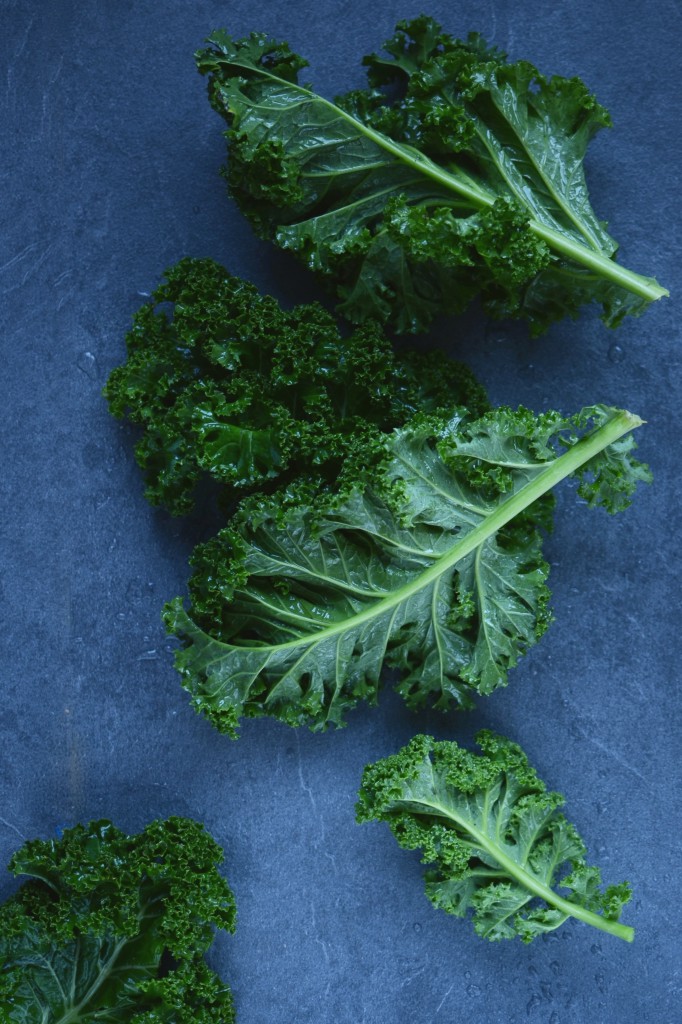
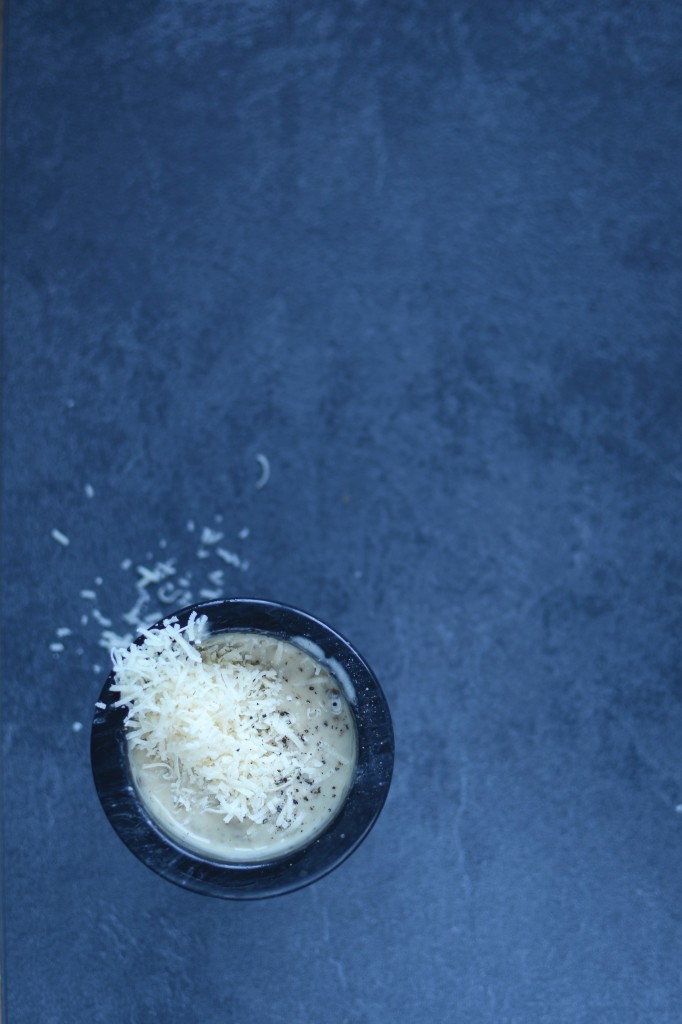
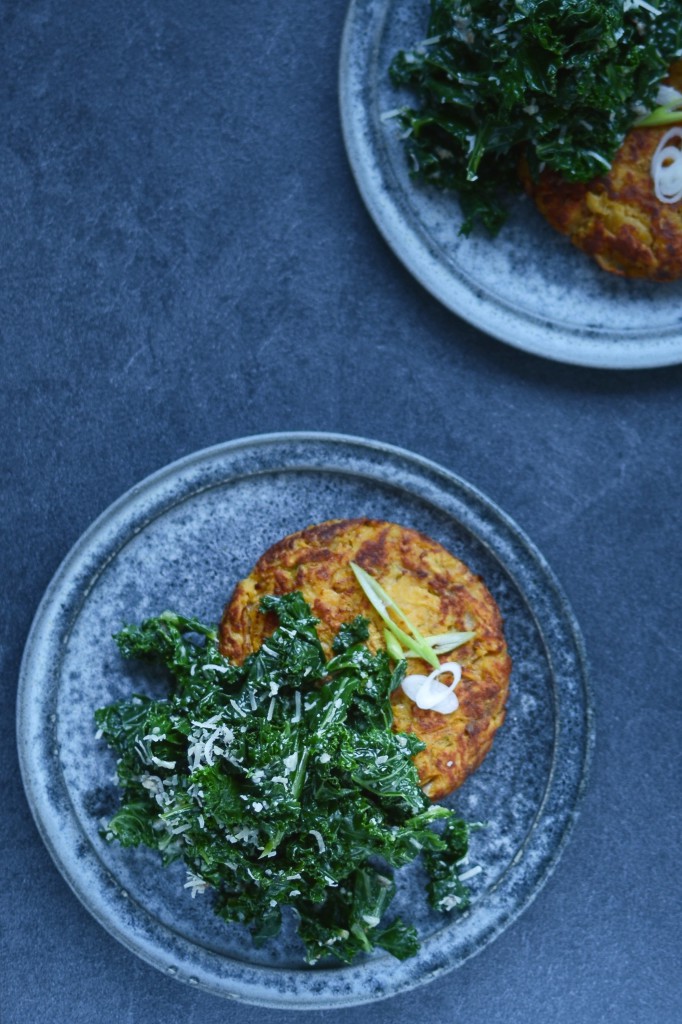
This is a fantastic meal, be it for breakfast, brunch or a light supper. Like most things in life, it tastes even better with an egg on top.
Serves 4 – 6
Ingredients for the rösti
4 medium (about 800g) sweet potatoes, peeled
2 spring onions, finely sliced
2 medium eggs, lightly whisked
40g (about 1/4 cup) wholemeal spelt flour or flour of your choice (I use a gluten-free mix)
butter or ghee for frying
Ingredients for the kale
5 anchovy fillets packed in oil, drained and chopped
1 small garlic clove, peeled and chopped
small pinch of coarse salt
60ml (1/4 cup) mayonnaise, preferably home-made
15ml (1 tablespoon) freshly squeezed lemon juice
15g (1/4 cup loosely packed) finely grated Parmesan
Freshly ground black pepper
300g kale, thick stalks discarded and torn or chopped into bite-sized pieces
Method
- For the kale: make the dressing, by placing the anchovies, garlic and salt in a mortar and pounding them together until you have a paste.
- Stir in the mayonnaise, lemon juice, Parmesan and pepper, and set aside.
- For the rösti: boil two of the sweet potatoes in a little water until they are just tender around the outside (do not let them get too soft!). Remove from the pot and allow to cool.
- In the meantime, coarsely grate the other two sweet potatoes and mix with the spring onions, eggs and flour.
- Finally, coarsely grate the slightly softened sweet potatoes and carefully combine with the rest of the ingredients.
- Heat a little butter or ghee (or coconut oil) in a frying pan until hot (but not smoking), then add enough batter to make a patty shape. Press down on the batter to ensure it is compact and will hold together.
- Fry for roughly 5 minutes on each side, or until golden and crispy. Carefully remove with a spatula and keep warm while frying the rest.
- Whilst your final rösti is frying, gently wilt the kale in a little water over a medium heat. As soon as it is tender, drain, return to the pan and stir through the dressing.
- Serve the dressed kale on top of the rösti with or without eggs.
*This blog post was written in collaboration with M&S. All content and photos my own.
Roasted pumpkin with green sauce
I spent some time in beautiful Hamburg in my early 20’s. My neighbour opposite was also a keen cook and I remember chatting to him about his favourite local dishes (his was Steckrübeneintopf). When he asked me whether there were any particular South African specialities I loved, it took about 1 second for “Pumpkin Fritters” to leave my mouth, a little more loudly than I had intended. He was horrified. “Pumpkin? That is what the pigs eat here in Germany…” Say what?! Naturally I rose to the challenge and, once I had finally sourced a pumpkin, made him some Pampoenkoekies. I believe he was a converted man.
This dish is a lovely make-ahead option for the colder months. Use whatever squash or pumpkin you have, but it is particularly delicious with sugar pumpkin. The green sauce is very moreish and good with any type of grain or pulse-based salad. It will thicken in the fridge, but just give it a good whisk and it should be pourable.
Roasted pumpkin with green sauce
Serves 4 – 6
Ingredients for the sauce
80ml (1/3 cup) coconut milk (if using organic, stand the tin in warm water to melt the fat)
30ml (2 tablespoons) lime juice (about 2 medium limes)
1/2 teaspoon unrefined salt
1/2 small avocado
Juice of 1 tangerine
1 spring onion
large bunch (100g) fresh coriander, leaves and stalks
medium bunch (50g) fresh mint, leaves only
1 teaspoon raw honey
1 green chilli (more or less to taste), seeds removed if you prefer it less spicy
For the rest
1 fennel bulb, the tough outer layer peeled (or a couple of stalks celery)
1 spring onion, finely sliced
3 cups cooked lentils and/ or quinoa
unrefined salt
crumbled goats cheese
roasted pumpkin (I used kabocha squash, but for an extra delicious option, try sugar pumkin)
toasted pumpkin seeds
Method
- Put all the ingredients for the dressing in a blender and blend until smooth. Set aside.
- Separate the layers of the fennel bulb, then chop into small squares. Sauté in a little coconut oil until tender.
- Combine the fennel with the rest of the ingredients, dress with the dressing and serve.
Beet and butternut “fasagne”
I love this time of year, just before the clocks go back. It is sometimes frosty, but mostly bright and often sunny. The Boston ivy cascading over the garden wall has embraced its beautiful autumnal coat of reds, yellows and oranges, while the climbing rose is fighting the change of season with a last few brave blooms. The produce at the farmer’s market is now distinctly different from the offering even a month ago. And our appetites have definitely veered towards more warming, comforting dishes. This fasagne (my son’s name for “fake” meat-, gluten- and (mostly) dairy-free lasagnes) is a delicious way to feed a gathering. It does involve a few steps, but nothing is too complicated or time-consuming. I often double the quantities and freeze one.
Beet and butternut “fasagne”
Serves 6 – 8
Ingredients for the cauli-béchamel
2 medium cauliflowers, florets steamed until tender (about 1.2kg cooked weight)
30g (2 tablespoons) unsalted butter (preferably organic and grass-fed), omit if vegan or dairy-free
1 teaspoon good quality unrefined salt
2 1/2 teaspoons nutritional yeast flakes (available at health stores and most good supermarkets)
heaped 1/2 teaspoon freshly grated nutmeg
Ingredients for the beet & tomato sauce
extra virgin olive oil
400g red onions, finely chopped (300g chopped weight)
1.4kg (about 14) tomatoes, peeled, deseeded and roughly chopped (or use tinned if you prefer)
500g beetroot, peeled and coarsely grated
1 teaspoon good quality unrefined salt
freshly ground black pepper, to taste
thumb-sized piece of fresh ginger, peeled and grated
Ingredients for the rest
1 large or 2 medium butternut squashes, peeled
extra virgin olive oil
350g (roughly 2 medium) leeks, washed, cut in half length ways and finely sliced
3 garlic cloves, finely chopped
400g chard, washed, stalks finely chopped and leaves finely shredded
1/2 teaspoon good quality unrefined salt
large handful of finely grated Parmesan, optional
Method
- In a blender or food processor, blend all the ingredients for the béchamel and set aside.
- For the tomato sauce, sweat the onion in a large heavy bottomed saucepan in a glug of olive oil over a medium heat until soft an translucent. Add the rest of the ingredients and simmer uncovered, stirring occasionally, until the mixture has a chutney-like consistency (about 30 minutes).
- While the tomato sauce is simmering, prepare the rest of the layers. Cut the butternut squash(es) in half just above the rounded end. Set aside the half with the seeds for use at a later stage (try the Pumpkin Pie smoothie in my book Good Better Green). Slice the other half into thin slices, roughly 0.5cm/1/4” thick. These will form your lasagne sheets. Place the “sheets” in a large saucepan and boil in a little water until just tender when tested with a sharp knife. Be careful not to let them cook too soft. Carefully remove with a slotted spoon and set aside.
- Pour the water from the butternut saucepan and add a glug of olive oil. Gently sweat the leeks and garlic until soft. Add the salt and chard stalks and continue to cook over medium heat until tender. Finally add the chard leaves and cook until wilted. Set aside.
- You are now ready to assemble the lasagne. In a large ovenproof dish, place a layer of butternut squash “sheets”. Spread half the tomato sauce on top, then half the béchamel followed by all of the chard and leek mix. Repeat the process, ending with a layer of béchamel.
- For an extra-delicious end result, sprinkle grated Parmesan over the top, then bake for roughly 1 hour at 180°C/360°F. It should be bubbling around the edges and the butternut “sheets” should be very tender when tested with a sharp knife. Remove from the oven and allow to cool for 10 minutes before serving with a large green salad.
Melon and avocado poke
This is refreshing and utterly summery. Unlike the British weather. (Here’s hoping the guys at the met office are right about that heat wave…) Poke (pronounced poke-keh) is a Hawaiian staple and can be found in many different guises, with chunks of tuna marinated in soy being the most popular and ubiquitous. This is a meat- and fish-free version and something I love eating whilst sat on my garden chair with the sun kissing my toes. It serves 4 as a starter, but I often eat the entire bowlful for lunch. Whatever you do, only attempt this if you can get your hands on seriously good melons.
Melon & avocado poké with nori crisps
Serves 4 as a starter
Ingredients for the nori crisps
2 sheets nori
white sesame seeds
sesame oil
sea salt
Ingredients for the dressing
15ml (1 tablespoon) extra virgin olive oil
5ml (1 teaspoon) rice wine vinegar
5ml (1 teaspoon) toasted sesame oil
15ml (1 tablespoon) tamari
30ml (2 tablespoons) lemon juice
1/2 – 1 teaspoon raw honey
1 teaspoon each of white and black sesame seeds, plus more for garnish
pinch of dried chilli flakes (or to taste)
1 shallot, very finely chopped
1 large clove garlic, finely chopped
Ingredients for the poké
500g (3 1/2 cups) diced watermelon (or a mixture of melons)
2 ripe avocado, cut into small dice
large handful sugar snap peas, thinly sliced lengthways
1 spring onion, finely sliced
sea salt
Method
- For the nori crisps: Preheat the oven to 140°C (275°F). Line a large baking sheet with parchment paper and set aside. Place two sheets of nori, shiny side up, on a chopping board. Using a pastry brush, lightly brush one sheet with water, then press the other one firmly firmly on top to stick the two together.
- Now brush the uppermost sheet with sesame oil, sprinkle on some sea salt and sesame seeds, and using scissors or a sharp knife, cut the nori into thin strips.
- Arrange the strips in a single layer on the baking sheet and bake for 15 to 20 minutes or until they have turned crispy and dark green. Remove from the oven and allow to cool.
- For the dressing: Combine all the ingredients in a jar and give it a good shake. Taste and adjust seasoning.
- To serve: Gently toss together the melon and other poké ingredients with the dressing and serve immediately topped with nori crisps.
Red Velvet Ice Cream Sandwiches
If you have never tasted a slice of red velvet cake with cream cheese frosting, you may not understand what all the fuss is about. Its intriguing name refers partly to its smooth and velvety texture, and partly to the sensual red colour, which is achieved in most modern recipes by adding (lots of) red food colouring to a chocolate cake batter.
Both these features were, however, originally due to the reaction of an acid (like vinegar or buttermilk) with the cocoa powder in the batter, which not only created bubbles and aeration, but also enhanced the red anthocyanin in the cocoa, a compound (also found in foods like red cabbage) that gets more red in the presence of strong acids. However, these days most cocoa powder undergoes Dutch processing, where an alkalizing agent is added to neutralise its acidity. Hence the need for (lots of) red colouring was created amongst bakers, and expertly fulfilled in the US by Adams Extract, a Texan company with good marketing sense.
But now for the really interesting bit. For our purposes today, at least. During the Second World War, bakers used reduced beet juice to enhance the colour (and texture) of their cakes, including the infamous Red Velvet cake, and give otherwise cheap bakes a dramatic appearance. Ah ha! As you know, adding vegetables to any kind of dish is my forte, so I present to you: the very beet-y red velvet ice cream sandwich.
Red velvet ice cream sandwiches
These sandwiches are a beguiling mix of earthy, sweet, cool and chewy. I used buckwheat flour to keep it gluten-free, but if you are not a fan of the taste, use stoneground spelt flour instead. Be sure to freeze the sandwiches until firm, or else you will end up with more ice cream on your shirt than between your biscuits!
Makes 8 sandwiches
Ingredients for the ice cream
200g roasted beetroot (about 500g peeled, raw beetroot)
1 whole vanilla pod
1 can coconut milk, gently warmed to melt the fat
60ml (1/4 cup) raw honey, plus a little extra to taste
flesh of 1/2 ripe avocado (about 50g)
15g (2 tablespoons) organic unsweetened cocoa powder
7g (1 tablespoon) arrowroot powder, dissolved in 15ml (1 tablespoon) water
Ingredients for the cookies
1 tablespoon ground golden linseeds (flax seeds)
60ml (1/4 cup) milk of your choice
60ml (1/4 cup) melted coconut oil
60g (1/2 cup) coconut blossom sugar
1 teaspoon good quality vanilla extract
30g (1/4 cup) organic unsweetened cocoa powder
1/2 teaspoon baking powder
pinch of sea salt
160g (1 cup) buckwheat flour
Method
- For the ice cream: put all the ingredients, except 2/3 of the coconut milk and the arrowroot powder slurry, in a blender and blend until smooth. Set aside. (If you do not have a high speed blender, scrape out the seeds of the vanilla pod and only use these – pop the pod in your coffee or sugar pot.)
- Whisk the arrowroot slurry into the rest of the gently warmed coconut milk. As soon as it thickens, remove from the heat, and once cooled, add the beetroot mix and whisk. Refrigerate until cold.
- For the cookies: whisk the ground linseeds and milk together. Set aside for a few minutes to allow it to swell.
- Whisk the oil and sugar together until light and frothy. Add the vanilla & linseed mix, then sift the dry ingredients into the wet. Mix together briefly until you have a ball of dough.
- Using a small ice cream scoop or a tablespoon, scoop 16 dough balls onto a baking sheet (no need to grease) and flatten each ball (I use a small palette knife to do this).
- Bake for 10 minutes at 180°C/360°F. Allow to cool slightly before transferring to a cooling rack.
- For the sandwiches: churn the refrigerated ice cream mixture in your ice cream maker.
- Transfer the soft ice cream to a shallow container that will yield a slab of ice cream 3 – 4 cm thick. Pop it in the freezer until almost solidly frozen, then use a cookie cutter the same size as your cookies to cut out ice cream rounds and place between two cooled cookies. You could also remove the ice cream slightly earlier and use an ice cream scoop to place one scoop between two cookies and press down lightly.
- If you would like to make these ahead of time, put the sandwiches in a container in the freezer and remember to take them out at least 5 – 10 minutes before eating.
Note:
To roast the beetroot, scrub clean, peel and cut into medium dice. Toss lightly in melted coconut oil and roast at 180°C/360°F until tender (about 1 hour), turning every so often. Be careful not to let them burn.
If you do not own an ice cream maker, you can make the ice cream by freezing the mixture and whisking it every 30 minutes or so, to prevent the formation of ice crystals.
Crustless courgette quiche
Zucchini. Courgette. Summer squash. Or baby marrow, as it is called in South Africa. I have a love-hate relationship with this veg. It tastes great grilled, marinated or slathered in dressing, but it is not the most nutrient dense choice, and I struggle to get it down raw (I know, I shouldn’t be admitting this, given the current zoodle fad…) And it really is a tad boring, if you’re honest. Having said that, it is a regular in my shopping basket, as its neutral taste means it is a good canvas for more exciting things, and makes it rather versatile from being grated into omelettes, breads, fritters and even brownies (check out the recipe in my book!), to featuring in beautiful sides such as a this one. Another surefire way to make the most of the humble zucchini, is this gluten- and grain-free quiche. It looks spectacular and tastes pretty darn good too.
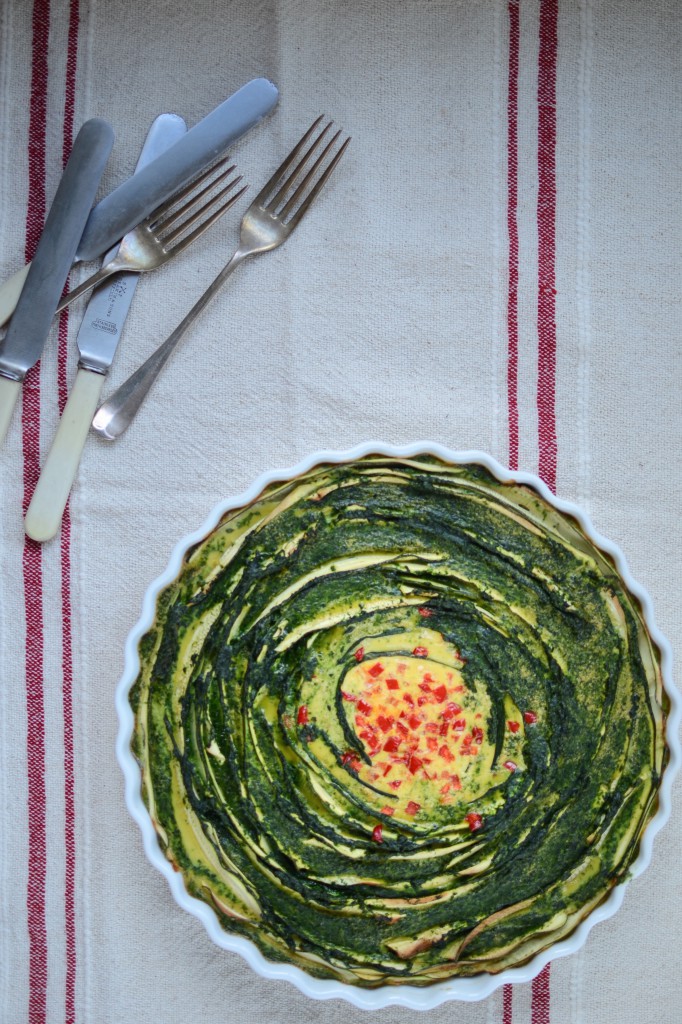
Crustless Courgette Quiche
The leek and egg mix forms a rather delicious grain-free base and helps keep the courgette slices upright. Feel free to add a large handful of good quality grated Parmesan to the filling if you like – it will make it even more delicious!
Ingredients
Knob of butter or glug of extra virgin olive oil
2 leeks, trimmed, cut in half length-wise and thinly sliced (about 250g)
1 medium onion, finely chopped
2 teaspoons mixed dried herbs such as oregano, thyme, parsley and marjoram
200g spinach
9 medium eggs, whisked
125ml (1/2 cup) milk of your choice
1 teaspoon sea salt
1/2 teaspoon cayenne pepper
4 medium courgette (about 550g), trimmed
1/3 red pepper, finely diced
soft goats cheese (optional)
Method
- Butter a 27/28cm oven-proof round dish and pre-heat the oven to 180°C/360°F.
- In a medium saucepan, sauté the leeks, onion and dried herbs with some of the salt over a low to medium heat until soft. Scrape into a bowl and allow to cool.
- In the same saucepan wilt the spinach (the water left over after washing should be enough), then remove from the heat and set aside to cool slightly.
- Use a mandolin (or a very sharp knife) to thinly slice your zucchini. Thin enough to bend, but thick enough to stand up on its side (about 3mm).
- Add 125ml (1/2 cup) of the whisked egg to the cooled leek mix. Spread this over the bottom of your buttered dish.
- Place the wilted spinach in a blender with the rest of the eggs, milk, salt and cayenne pepper, and whizz until the spinach is well blended.
- Now start placing the courgette slices into the leek “base”, starting along the edge of the dish, for stability, working your way inwards. Leave a little space between the “petals” of your rose, if possible. I steamed the slightly thicker rind pieces first, before slotting them into the rose, as they aren’t malleable enough otherwise.
- Now carefully pour the spinach egg mix in between the courgette petals, ensuring an even distribution.
- Finally scatter the little red pepper dice into the centre and bake for roughly 1 hour or until set in the centre.
- Serve with a mixed salad, soft goat’s cheese and additional red pepper dice.
Lamb steak, puntarelle and rosemary brittle
I love the Italians! Not only do they know how to live passionately, but they also rock on the green vegetable front, especially when it comes to bitter greens. One of my favourites is puntarelle or catalogna – a loose leafed variety of chicory favoured by most Romans, also referred to as Catalonian or asparagus chicory. The word “puntarelle” actually refers to the pale green inner stalks that have asparagus-like tips, whilst the outer leaves are similar to dandelion both in taste (they are very bitter!) and appearance. If you would like a step-by-step tutorial on how to prepare this vegetable, Nick Anderer explains it all here. For a quick overview, I’ve included the steps below. This fabulous vegetable is only in season in the colder months, but with Easter a little earlier than usual, perhaps this salad will still be a possible addition to your festive feast! It will be equally good with dandelion greens, chicory and radicchio, however, if you cannot find puntarelle.
Lamb steak, puntarelle and rosemary brittle
Ingredients for the salad
2 lamb steaks
splash of extra virgin olive oil
2 – 3 sprigs of rosemary
2 – 3 large garlic cloves, peeled and sliced
1 butternut or coquina squash, cut into rings and roasted until tender
1 head of puntarelle
Ingredients for the brittle
85g (just under 1/2 cup) unrefined brown sugar
50g (1/2 cup) chopped walnuts
15g (1 tablespoon) unsalted butter
1 tablespoon finely chopped fresh rosemary
1/2 teaspoon course ground sea salt
Ingredients for the dressing
2 cloves garlic
1/2 teaspoon coarse sea salt
1 tablespoon finely chopped fresh rosemary
5 – 6 marinated anchovies, drained
30ml (2 tablespoons) mayonnaise (preferably home-made)
80ml (1/3 cup) extra virgin olive oil
30ml (2 tablespoons) fresh lemon juice
Method
- Rub a little olive oil into the meat, then place into a shallow glass dish and press the rosemary and garlic on top. Allow to marinade for a couple of hours, then remove the rosemary and garlic, season with salt and pepper, and fry on a griddle until cooked to your liking. Set aside to rest for 10 minutes before slicing.
- For the puntarelle:
- Fill a large bowl with ice water and set aside. Strip away the dark green outer leaves – you will only need a handful of these to add to the salad. Use a sharp paring knife to separate the pale green core into its individual stalks, then thinly slice each lengthwise before dropping the slivers into the ice water. They need to soak for at least 45 minutes to achieve the traditional curly crispness that puntarelle is loved for.
- For the brittle:
- Line a large baking sheet with greaseproof paper.
- Place the sugar in a medium heavy saucepan over medium high heat and stir with a wooden spoon until sugar begins to melt. Lower the heat a little and keep stirring until all the sugar has melted.
- Now leave it to cook untouched until it is a dark caramel colour – you should be able to smell it. Stir in the walnuts and butter, and allow to cook for another couple of minutes, stirring constantly, or until the butter is incorporated.
- Stir in the rosemary and salt, then scrape the mixture out onto the prepared baking sheet. Spread it evenly to the desired thickness with a wooden spoon or stiff rubber spatula. Allow to cool completely (roughly one hour) then break it into pieces. You will probably have slightly more than you need for this salad, but the rest can be stored in an airtight container at room temperature and will keep a few days.
- For the dressing:
- Place the garlic and coarse salt in a mortar and grind into a paste.
- Add the rosemary and continue to grind until it is well mixed and resembles a speckled pulp.
- Add the anchovies and repeat until you have a thick paste.
- Now slowly whisk in the olive oil until it is incorporated, followed by the mayonnaise and lemon juice.
- To assemble your salad, combine the sliced lamb, roughly chopped puntarelle greens, drained and dried puntarelle stalks and roasted squash, and toss with enough dressing to coat. Scatter over the brittle and serve immediately.
Mackerel and romanesco with preserved lemon
Writing a book about greens has helped me rekindle relationships with some vegetables that I have neglected somewhat, such as this little beauty, the romanesco. It looks like the strange yet stunning lovechild of Mr Broccoli and Ms Cauliflower, but is indeed a unique Italian variety of broccoli that develops multiple compact heads that can be individually snapped off. Each bud is composed of a series of smaller buds, all arranged in a logarithmic spiral, and this pattern continues at several smaller levels. To retain the gorgeous green hue after blanching or steaming, be sure to shock the florets in ice cold water. Nutritionally, romanesco is rich in vitamin C, vitamin K, dietary fiber and carotenoids.
Mackerel and romanesco with preserved lemon dressing
Serves 4
Ingredients for the salad
85g (1/2 cup) wild rice, rinsed, soaked in fresh water overnight and cooked until tender
3 smoked mackerel fillets, skin discarded and flaked
one large handful of rocket per person
150g large green olives, pitted and halved
45g (a heaped 1/4 cup) organic raisins
1 small head of romanesco, cut into florets and lightly steamed until tender, then shocked under ice cold water (90g reserved for dressing)
Ingredients for the dressing
2 small preserved lemons, pulp discarded and peel roughly chopped (about 2 tablespoons)
90g (about 3/4 cup) cooked romanesco
125ml (1/2 cup) extra virgin olive oil
45ml (3 tablespoons) lemon juice
1 – 2 teaspoons Dijon mustard
2 – 3 teaspoons raw honey
2 tablespoons fresh thyme leaves
small bunch of dill
freshly ground black pepper
sea salt to taste
Method
- Put all the ingredients for the dressing in a blender and blend until smooth and creamy. Set aside.
- Combine all the salad ingredients, season with salt and gently toss with enough dressing to coat.
Note: It is possible to enjoy wild rice – the seed of an aquatic grass and not a grain at all! – in its raw form, if you allow it to sprout (or “bloom”). Rinse the rice well, then soak in fresh water for 2 to 3 days, changing the water twice daily. You will know it is ready when most of the rice kernels have split open and are soft.
A winter salad with blood orange and lentils
I’m not sure that I agree with a strict interpretation of the whole “New Year Detox” thing. At least not if you live in the Northern hemisphere. Sure, cut down on portion sizes and avoid sweet things if you overdid it during the festive season. But why deny yourself warming, filling and indulgent food when it is bound to be cold, dark and wet most of the time? And on the days you do crave something a little fresher, a little bit brighter, a salad such as this one will hit the spot while keeping the winter chills at bay.
Blood oranges are such a treat in the colder months and add a sense of drama to any dish. Before juicing the halves for the dressing, I cut off one slice and add this, with the skin still on, to the blender. This, and the tahini, add a delicious bitterness to the salad, which I find particularly appealing, but feel free to omit it. If you struggle to find the shichimi togarashi spice blend for the dressing, you could make your own by combining 2 tablespoons of chilli flakes, 1 teaspoon coarsely ground sichuan (or black) peppercorns, a tablespoon each of white and black sesame seeds, and dried tangerine or orange peel, 2 teaspoons of ground ginger, and lastly 2 tablespoons of seaweed (nori, wakame flakes or arame). Also remember, when consuming raw spinach, to include foods in the meal that are high in vitamin C (such as blood oranges), as it helps with assimilation of the iron and blocks the oxalate from binding to calcium, encouraging further absorption.
Lentil and blood orange salad
Serves 2 – 4
Ingredients for the dressing
1 blood orange, 1 slice and the rest juiced
80ml (1/3 cup) extra virgin olive oil
15ml (1 tablespoon) tahini
30ml (2 tablespoons) rice vinegar
15ml (1 tablespoon) naturally fermented shoyu or soy sauce
1 tablespoon maple syrup
squeeze of lemon
pinch of sea salt
shichimi togarashi (Japanese 7-spice blend) to taste
Ingredients for the salad
100g (about 1 cup) cooked puy lentils
2 large handfuls of greens, including baby spinach
1/2 large cucumber, sliced
2 blood oranges, peeled and sliced
1 large carrot, grated or thinly sliced
1/2 medium fennel, grated or thinly sliced
2 spring onions, thinly sliced
Method
- Blend together all the dressing ingredients. If you don’t own a high-speed blender, do not add a slice of orange with the peel on, as it will not be ground up smoothly enough. Instead, add some grated zest. Adjust seasoning, ensuring a lovely balance between salty, bitter, sweet and sour.
- Just before serving, toss together the warm lentils, the rest of the salad ingredients and enough dressing to coat.

